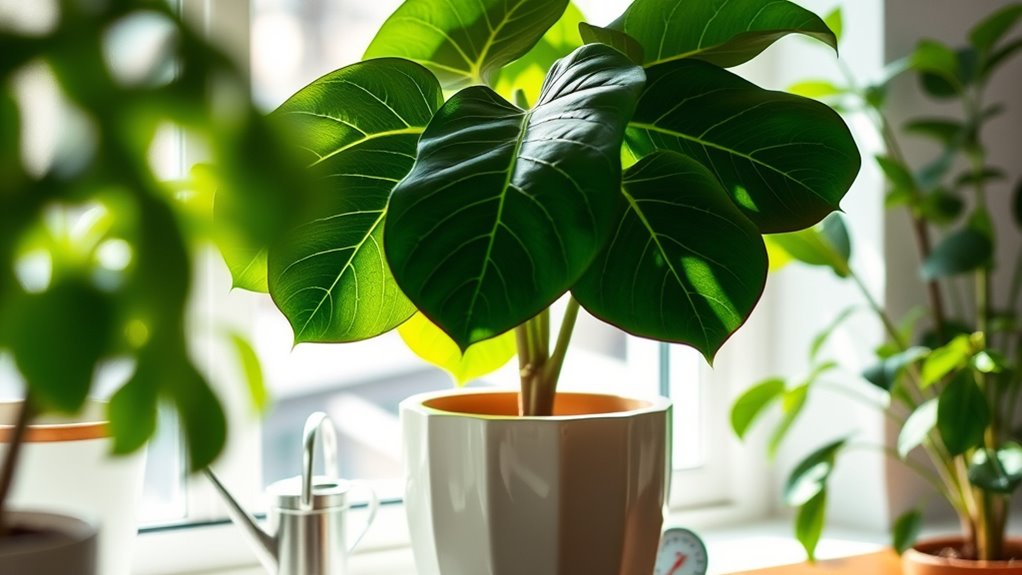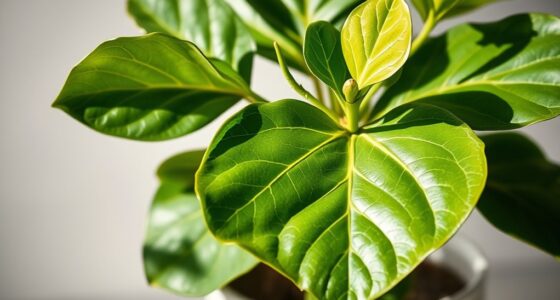To keep your fiddle leaf fig growing consistently, make sure you water when the top inch of soil feels dry, adjusting for seasons. Avoid overwatering to prevent root rot and guarantee the soil drains well. Regularly prune dead or damaged leaves with clean tools to promote bushier growth and prevent legginess. Stay vigilant about plant health and proper care practices—if you keep up with these tips, you’ll foster a thriving, lush plant that rewards your effort.
Key Takeaways
- Water the plant thoroughly when the top inch of soil feels dry, adjusting for seasonal changes.
- Avoid overwatering to prevent root rot and ensure proper drainage for healthy roots.
- Regularly prune dead or leggy branches to promote bushier, fuller growth.
- Sterilize pruning tools and remove no more than 25% of the plant at once.
- Monitor soil moisture consistently and adapt watering routines accordingly.

Have you ever wondered how to keep your fiddle leaf fig healthy and thriving? The key lies in establishing a proper watering schedule and mastering effective pruning techniques. These two aspects are essential for encouraging steady growth and maintaining the plant’s overall vitality. When it comes to watering, consistency is paramount. Your fiddle leaf fig prefers the soil to be moist but not soggy, so you should aim to water it thoroughly when the top inch of soil feels dry. Overwatering can lead to root rot, while underwatering causes stress and leaf drop. To get this just right, check your plant regularly and adjust your watering schedule based on the season, humidity, and indoor temperature. During warmer months, you might need to water more frequently, but in cooler seasons, less often is better. Always ensure excess water can drain freely to prevent water from sitting at the bottom of the pot, which can harm the roots.
Pruning techniques are equally essential in fostering healthy, consistent growth. Regular pruning helps remove dead or damaged leaves, improves air circulation, and encourages the plant to grow fuller and taller. When pruning, use clean, sharp scissors or pruning shears to make precise cuts just above a leaf node or bud. This encourages new growth from those points and keeps your fiddle leaf fig looking attractive. Don’t be afraid to prune back overgrown branches or leggy stems; doing so stimulates bushier growth and prevents the plant from becoming sparse or uneven. Remember, pruning isn’t just about aesthetics—it’s about supporting plant health. Always sterilize your tools before pruning to prevent infections, and avoid removing more than 25% of the plant at once. Regularly inspecting your fiddle leaf fig allows you to catch issues early and address them through targeted pruning.
Combining a consistent watering schedule with strategic pruning techniques creates an environment where your fiddle leaf fig can flourish. By paying close attention to the plant’s needs and responding appropriately, you’ll foster strong, steady growth that keeps your plant vibrant and beautiful. Remember that patience and observation are your best tools; with time, your efforts will reward you with a lush, thriving fiddle leaf fig. Stay attentive to watering cues and pruning needs, and your plant will become a stunning centerpiece in your home, thriving through the seasons.
Frequently Asked Questions
How Often Should I Repot My Fiddle Leaf Fig?
You should repot your fiddle leaf fig every 1 to 2 years, or when it outgrows its current pot. During repotting, check its soil drainage and replace it with fresh, well-draining soil to prevent overwatering. Align this with your watering schedule, making sure not to water too frequently. Repotting helps promote healthy roots and consistent growth, keeping your plant happy and thriving.
What Are Common Pests That Affect Fiddle Leaf Figs?
Imagine your fiddle leaf fig as a fortress, but pests like spider mites, mealybugs, and scale insects are tiny invaders trying to breach it. To keep them out, practice pest prevention by inspecting leaves regularly. If you spot pests, use natural remedies like neem oil or insecticidal soap. Staying vigilant and proactive helps protect your plant’s health and keeps your fortress thriving, ensuring consistent growth.
How Can I Encourage Bushier Growth in My Plant?
To encourage bushier growth, you should prune your fiddle leaf fig regularly, focusing on trimming back leggy stems and encouraging lateral branches. Use proper pruning techniques, making clean cuts just above nodes. Also, follow fertilization tips by applying a balanced, water-soluble fertilizer every month during the growing season. This promotes healthy, dense foliage. Consistent pruning combined with proper fertilization helps your plant develop a fuller, bushier appearance.
Is It Okay to Prune My Fiddle Leaf Fig?
Ever wondered if pruning your fiddle leaf fig is okay? Absolutely! Pruning techniques help regulate growth and promote a fuller, healthier plant. You should prune to remove dead or damaged leaves, encourage bushier growth, and maintain the plant’s shape. Use clean, sharp tools and make clean cuts just above a leaf node. Regular pruning keeps your fiddle leaf fig thriving and ensures consistent growth. Ready to give it a trim?
What Are Signs of Overwatering or Underwatering?
You’ll notice watering issues when your fiddle leaf fig’s leaves turn yellow or brown, or if the soil feels too soggy or too dry. Overwatering can lead to root rot, causing your plant to weaken or drop leaves. Underwatering, on the other hand, makes leaves wilt or become crispy. Monitoring soil moisture and adjusting your watering schedule helps prevent these problems, ensuring your plant stays healthy and vibrant.
Conclusion
By following these simple fiddle leaf fig care tips, you’ll enjoy lush, thriving foliage that rivals even the grandest of castles. Remember to water wisely, place your plant in bright, indirect light, and stay attentive to its needs. With patience and a bit of old-world charm—like whispering sweet nothings to your green companion—you’ll cultivate a healthy, vibrant fig that’s truly the belle of the botanical ball. Happy gardening, and may your plant flourish like a true Renaissance masterpiece!









